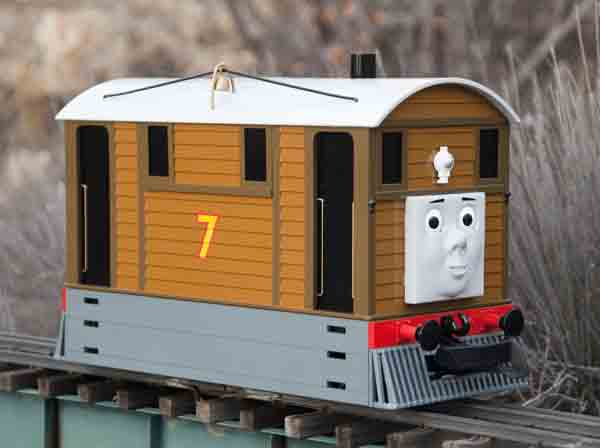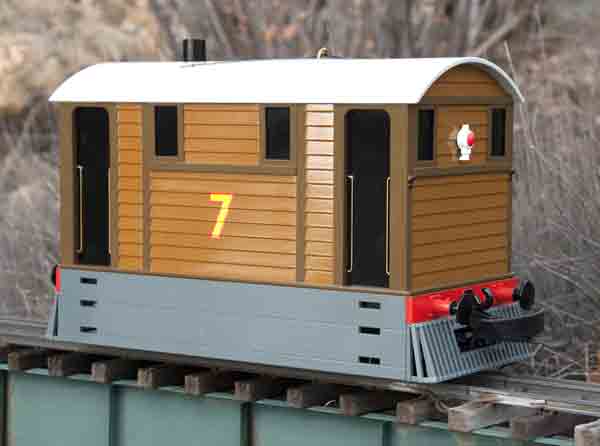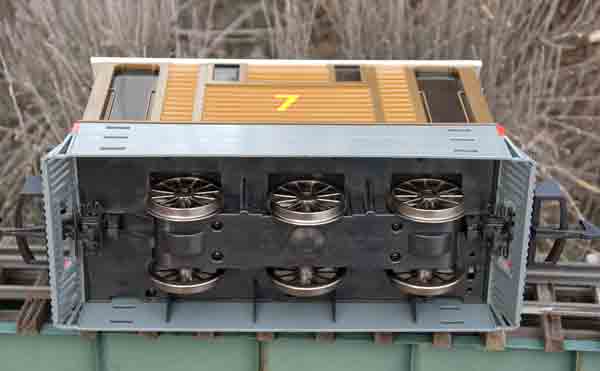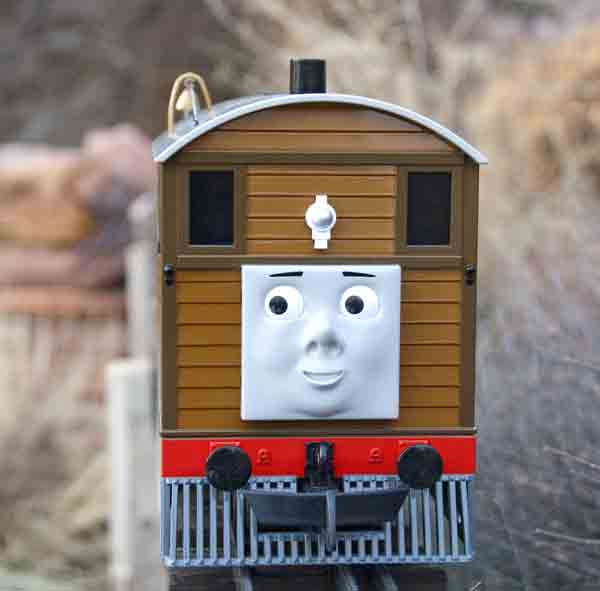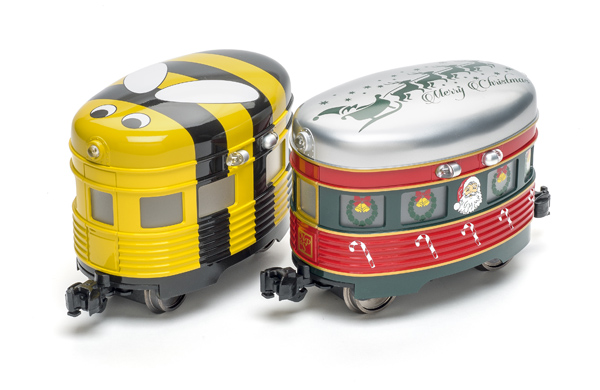Bachmann
1400 East Erie Avenue
Philadelphia PA 19124
Price: $295
Website: www.bachmanntrains.com
Large scale, gauge 1 model of Toby the Tram (#91405) from the Thomas the Tank Engine range; 0-6-0 wheel arrangement; all wheels flanged; power pickup from all wheels; moving eyes on the face at one end; hook-and-loop couplers; dummy buffers; plastic body; will negotiate R1 curves. Dimensions: Length over pilots, 10 3/8″; width, 4 3/8″; height over stack, 7 3/4″
Pros: Solid, robust construction; few detail parts to break off; moving eyes; excellent performance characteristics; extra coupler supplied
Cons: No instructions supplied; top speed (at 24V) very fast
Toby the Tram Engine is one of Thomas’ friends, of course. He is actually based on a full-size tram engine, a Great Eastern Railways (GER) Class C53, an 0-6-0T that ran on the Wisbech & Upwell Tramway (built by the GER) in East Anglia. This was a standard-gauge line and our review sample is built to standard-gauge proportions, though (incorrectly) gauged for 45mm-gauge track. That’s nit-picking, though, as this is a toy engine.
Toby is a simple, well-constructed locomotive. It is of the 0-6-0 variety, with all wheels flanged, and it takes power from the track via all wheels. The engine will negotiate R1 curves, thanks to excessive lateral play in the wheels. The wheels are beautifully spoked, though they will never be seen while the engine is in operation. Toby is powered by a motor integrated into a metal gearbox inside the body.
The body is made of a heavy plastic. There are pilots (cowcatchers) on both ends. All doors and windows are blanked out and painted black, so there is no visual access to the interior of the locomotive. The paint job and graphics are up to Bachmann’s usual high standard and they match the Toby of book and TV fame. There is a headlamp on the face end and a tail lamp on the rear end. However, these are only for show and do not actually light up. A bell atop the roof and its supporting “hardware” are made of a soft, flexible plastic that should help them survive the hard knocks of childhood.
In operation, Toby’s eyes move back and forth at a convincing speed, perpetually scanning the track for hazards. However, when Toby arrived at our offices, his eyes were not functional. In fact, they were crossed. While amusing, I felt this was not the manufacturer’s intent. No instructions were supplied with the engine and perhaps it was felt that none were necessary for such a simple locomotive. However, I always like to see some sort of instructional material supplied with products that may well fall into the hands of rank beginners in our hobby. In this case, it would have been nice to know if the eyes were even intended to work. I opened up the engine by removing the couplers and six screws from the underside. Inside I found a simple mechanism for powering the eyes that had become disengaged. Fixing the problem was quick and easy.
There was a slip of paper included with the locomotive that warned against excessive current draw—i.e., if you load too many cars behind the engine on a hot day going up a steep hill. If this should become a problem, the engine is equipped with a thermal circuit breaker that will automatically trip. Should that happen, you have nothing more to do than let the engine sit for 10-20 minutes, at which time the breaker will reset and it will be good to go again.
Also included is an exploded parts drawing, showing all of the pieces of the engine and how they go together. This will no doubt be handy for those who are more experienced and wish to modify the engine. There is plenty of space inside the shell for R/C gear and batteries, or DCC and sound boards, should you so desire.
The engine is excellent in operation. Slow speed operation (not that any kid would run it slowly) is very good indeed. Top speed, however, at 24V is excessive. The speed attained at 12V seems more like a reasonable top speed. Toby runs quietly at any speed. The oversize hook-and-loop couplers make coupling easy for even the smallest hands. An extra coupler is supplied in case of mishap.
Under the engine is a polarity switch that can be used to change from “NMRA” polarity to “Large Scale” polarity. If you’re running Toby by itself, you needn’t be concerned about this switch. If Toby is running with other engines on the same track, and wants to go backward while the other engines are running forward, simply flip the switch so they all travel in the same direction.
While this engine is designed as a toy, its proportions are close to the prototype and it has the presence of a standard-gauge locomotive. There are many people, especially in the UK, who are looking at these toys as potential material for kitbashing into plausible models for use in non-Thomas garden railways. Toby would definitely be a candidate for this. Remove the face, plank over the area occupied by it, replace the couplers with something more prototypical (proper hooks are already in place), replace the dummy buffers with sprung buffers, add some more detail and a little weathering, and you have a reasonable model of a Wisbech & Upwell Tramway locomotive. Purists could even regauge it to 21/2″ gauge.
For kids, however, Toby is an excellent product that should have a long life and give countless hours of playtime to young railroaders. This is a welcome addition to Bachmann’s “Thomas” range of trains.





